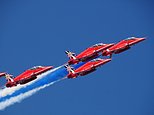British firm behind the NEW Red Arrows
British firm behind the NEW Red Arrows: Suffolk company is set strike a deal to develop replacement Hawk T1s amid fears over safety of 1974 aircraft
Aerobatic Hawk T1 plane has been used for more than 40 years by Red ArrowsSuffolk-based company Aeralis set to strike deal to replace the ageing aircraftsThe move, set to be confirmed at Christmas, comes amid concerns about safety
<!–
<!–
<!–<!–
<!–
(function (src, d, tag){
var s = d.createElement(tag), prev = d.getElementsByTagName(tag)[0];
s.src = src;
prev.parentNode.insertBefore(s, prev);
}(“https://www.dailymail.co.uk/static/gunther/1.17.0/async_bundle–.js”, document, “script”));
<!–
DM.loadCSS(“https://www.dailymail.co.uk/static/gunther/gunther-2159/video_bundle–.css”);
<!–
A British firm is set to strike a deal that will see it design and develop a replacement for the Red Arrows’ aircrafts.
Suffolk-based Aeralis was given £200,000 by the RAF to develop a new aircraft that could be converted from basic trainer to aggressive fighter by swapping engines and wings earlier this year.
But the jet developer is now set to win a contract that will see it replace the fully aerobatic Hawk T1 plane, which first entered service with the RAF in 1974, amid concerns about the aircraft’s safety.
The two-seat training plane, which has been used both as an advanced flying-training aircraft and a weapons-training aircraft, was expected to remain in service until 2030 for the RAF Aerobatic Team, the Red Arrows.
However concerns about the safety of the aircraft, which has been used in almost 5,000 public displays worldwide, have forced senior staff to push ahead with replacing the planes.
Suffolk-based Aeralis is set to strike a deal that will see it design and develop the fully aerobatic Hawk T1 plane
The jet developer is set to win a contract that will see it replace the two-seat training plane, which has been used both as an advanced flying-training aircraft and a weapons-training aircraft
The British firm will create nine planes for the Red Arrows and three operational spares, it is understood.
An RAF source told the Daily Express: ‘The Red Arrows promote British industry and the plane needs to be made in the UK. Aeralis will design, develop and deliver the Hawk T1 replacement.
‘Though officially the order date is being played down, given that it will take at least 5 years or longer before the plane is in operational service, there’s an acute awareness that the decision has to be made soon.
‘An announcement is pending and will be made before Christmas.’
It comes just months after Aeralis was given £200,000 by the RAF to develop a ‘modular’ two-seater aircraft that will come in one of three variants depending on requirements.
The variants have the same fuselage, but by fitting different engines and wings it can be transformed – allowing the RAF to operate with fewer aircraft in its fleet.
A base version of the aircraft will be used as a trainer for combat exercises, but the modular design means it can be adapted as circumstances change.
Aeralis expects the change between versions to happen within a normal 24 to 48-hour maintenance cycle, and to have the first version ready in about three years.
Speaking at the time, Tristan Crawford, CEO of Aeralis, said every component used in the making of the new module aircraft would come from British companies.
In February the Royal Air Force backed the British firm to develop a new aircraft that could be converted from basic trainer to aggressive fighter by swapping engines and wings
The variants have the same fuselage, but by fitting different engines and wings it can be transformed
This year Aeralis said the flexible design for the new aircraft could allow RAF training teams to have fewer aircraft available
‘We can put different wings on and different engines on so that it becomes a basic trainer for example, so it flies more slowly and it’s more easy to fly — like the flying equivalent of a family car,’ the aircraft designer told The Times.
The ‘revolutionary design’ allows for a number of future configurations beyond the three ‘core’ ideas currently under development.
Future versions of the aircraft could include a ‘fuel tanker’ – a flying petrol station that could be used to refuel swarms of small drones.
The firm said they could also create a version with much longer wings that could be used for surveillance missions, or an uncrewed version used as an attack drone.
‘The last time Britain developed its own crewed military aircraft fully in Britain was 1974 with the Hawk. Everything else that has come afterwards has had to rely on some kind of overseas partnership to make it happen,’ Mr Crawford added.
The £200,000 grant from the RAF is for three years development and was granted by the Rapid Capabilities Office – designed to fund novel ideas.
The firm said on their website: ‘The new aircraft will be based on a modular system, enabling the company to deliver a range of configurations for different missions by using common fuselage and avionics while switching engines, wings and mission systems.
‘The company has completed phase one and phase two development, with feasibility studies complete and its core team established in preparation to develop a pre-production aircraft with first flight targeted within three years.’
![]()


